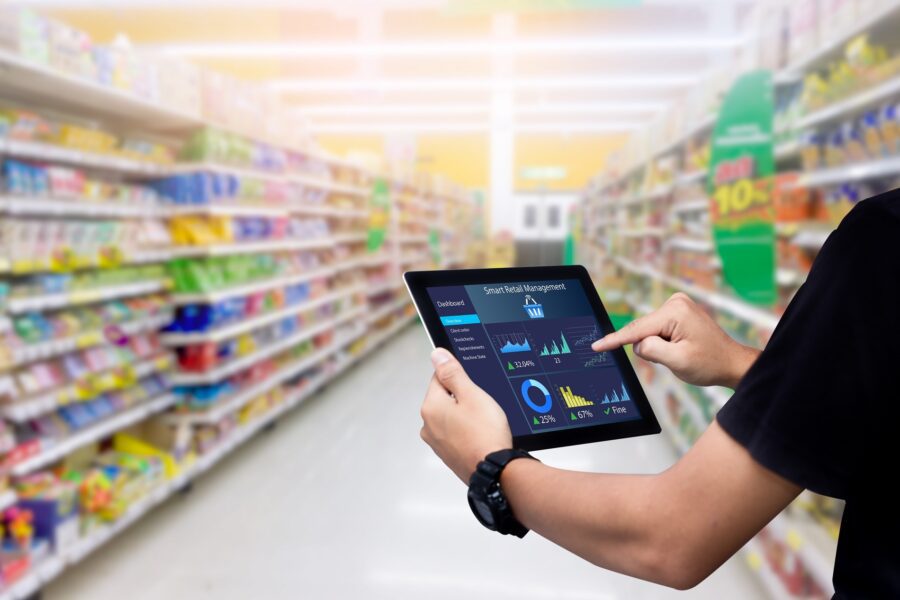
Our Blog
5 Retail Innovation Concepts
Written by: Parcel Pending
7 Min Read
Published: January 16, 2020
Updated: April 3, 2023
The increased digitization of the world has created a new kind of shopper. Consumers are demanding more and more from their in-store experience, forcing companies to innovate quickly.
Furthermore, the acceleration of innovation in retail due to new technologies has made it more difficult to keep up with 2020 retail trends. Plus, e-Commerce has emerged as an almost monopolistic power in several geographic markets, providing every customer with enhanced bargaining power when selecting between retailers.
As online shopping quickly cannibalizes sales at traditional brick-and-mortar retail stores, it has become imperative for all retail companies to pay close attention to the most important innovations in the industry.
Fortunately, we have it covered. Check out our list of the five most important innovations in retail right now:
- The emergence of virtual and augmented reality
- Omnichannel commerce
- Buy online and pick-up in-store (BOPIS)
- Customization
- Faster delivery.
1. Virtual and Augmented Reality
When analyzing retail innovation, virtual and augmented reality platforms have huge implications on the future of commerce. Some companies have already adopted this technology, implementing it in both online and brick-and-mortar sales channels.
- On the online side, various large companies have transformed their sales offerings, permitting customers to visualize a product prior to purchasing it. Many companies allow consumers to see how an outfit would look on them or picture how a couch or bed fits into their living space, before making a decision.
- For brick-and-mortar shopping, retailers are integrating an increasing number of smart technologies into their physical stores. It’s now commonplace to have some sort of Virtual Reality experience available in-store. This can be an extremely useful technique when learning how to increase foot traffic in a retail store, while at the same time, enabling retailers to market products directly to customers.
Of course, these technologies are still emerging and have yet to experience widespread adoption. Expect further innovation and technology in the VR and AR space, as it has the potential to revolutionize the modern shopping experience.
2. Omnichannel Commerce
While omnichannel commerce has been widely adopted within the retail space, it is impossible to ignore because of its critical importance to the industry. At its core, omnichannel commerce is a full integration of all sales channels, which improves staff efficiency and provides invaluable data and analytics to a retailer.
The idea of solely employing one or two sales channels is quickly fading. Companies that may have originally started as online-only retailers are opening their own brick-and-mortar outlets, and vice versa. Companies are increasingly marketing and selling their products through social media sites and other third-party outlets, simultaneously accruing data about individual shoppers.
However, omnichannel commerce is more complex than simply expanding to several channels. The key to successful omnichannel commerce is a full integration of different sales channels, which allows shoppers to seamlessly move between them, allowing retailers to easily monitor and store information about consumers’ preferences for enhanced targeting techniques.
As more and more retailers employ this method, shoppers will grow to expect this type of service on a consistent basis.
The Modern Shopper
This requirement has emerged because the modern shopper has changed. They demand more than one channel to purchase goods. This is, of course, compounded depending on the product offered and the individual consumer, with research indicating that customers that utilize the full scope of omnichannel commerce are more valuable to retailers.
The Harvard Business Review conducted a study indicating that not only do shoppers that employ more channels purchase more goods, but also these shoppers are becoming increasingly common—over 70% of modern consumers utilize more than one channel.
Retailers have quickly caught on to the trend and are providing various outlets for consumers to purchase goods, while at the same time focusing their efforts on anticipating customer needs through full integration of these channels. It has now become essential for any successful retailer to utilize the full potential of omnichannel commerce because it helps to increase foot traffic in a retail store.
3. Buy Online, Pick-up in Store
Consumers are requiring new ways to collect their items with omnichannel commerce. Of course, delivery has become an essential channel for all major retailers, but so is picking up items in a timely manner. A major requirement for a modern retailer is to make a customer’s shopping experience seamless with a fluid online shopping experience that enables the acquisition of goods done quickly with little to no human interaction.
Due to this requirement, retailers have adopted pick-up options that streamline efficiency. Many retailers now employ smart lockers—like the ones offered by Parcel Pending—where customers can pick up their items without having to wait in long lines or even speak to a representative. Buy online, Pick-up in Store (BOPIS) has emerged as an important sales channel for individual retailers, especially when considering the threat that e-Commerce has posed to more traditional retail establishments.
This is due to the fact that customers still do prefer the options offered by brick-and-mortar shops, including:
- The ability to try on or try out items, especially in fashion and makeup industries
- To see competing or similar items
- To physically see and hold the item
- The ease of the return process
As the preferences of modern consumers shift, companies that provide an efficient process for collecting and distributing items are one step ahead of other retailers.
For this reason, it is crucial for retailers to employ new techniques aimed at optimizing the customer experience when shopping online and picking up their items in-store. This has emerged as one of the few ways that brick-and-mortar retailers can fend off the major competitive threat of online shopping.
Many retailers are now outsourcing their BOPIS operations to innovative firms who can assist in making this process more efficient for the customer and a less cumbersome procedure for their in-store employees.
4. Customization
Customization is something that has been present within the retail space throughout its history. However, it has traditionally been reserved for wealthy shoppers due to the fact that tailored products were almost always very expensive. But, due to recent innovations in technology, the retail market is now witnessing a clear emergence of “budget” customization like never before.
While many online retailers have allowed shoppers to customize clothing for the last few years at a reasonable price, this typically required customers to send in their own measurements. The problem has always been that the quality suffered due to the limited accuracy of at-home measurements. This is no longer the case, as many prominent retailers have invested in new technologies that can customize clothing and accessories like never before.
- Some companies use body-scanning software to facilitate the tailored clothing production experience
- Shoe retailers offer customization and personalization software online and in-store
- Some firms allow customers to personalize other clothes with embroidery or prints due to the new ease of production.
And this is solely with the fashion industry. Customization is an innovation that has yet to be completely adopted within the retail market, and it is likely that we have yet to experience the full potential of these emerging technologies.
5. Faster Delivery
Delivery speeds are at an all-time high. Amazon is offering same-day shipping in some countries, with one-day shipping becoming commonplace in the US. This innovation does require a certain level of scale to accomplish such delivery speeds, but this is the new reality for retail.
Furthermore, innovation in delivery is only just beginning. We have seen investments in drone delivery mechanisms, while other companies are looking towards robots to solve their delivery needs. As an increasing number of consumers demand the highest possible delivery speeds, the retail market is just on the cusp of delivering on these customer requirements.
The continued decline of brick-and-mortar retail will come hand-in-hand with increased innovation in delivery. Ease of return is one of the biggest factors holding up further decline, as many shoppers avoid purchasing certain goods online if they have to pay for or exert too much effort on returns.
Innovation in returns could be the factor that really levels the brick-and-mortar model. While people are becoming more comfortable returning items via mail or through drop-off locations, any further innovation in the way customers return goods ordered from the internet could have a major effect on the industry.
Considering this trend, retailers that fall behind on delivery must invest in their own methods to increase speeds or outsource delivery and return processes to a third-party provider. It is unlikely that companies who ignore delivery innovations will be able to keep up with retailers that provide customers with one-day delivery or potentially faster methods in the future.
Innovate and Revolutionize
Whether a company is geared more towards online or brick-and-mortar sales, it is necessary for the modern retail market to pay close attention to new trends in the sector. New technologies have increased the rate of innovation, and companies who are early adopters enjoy an increase in sales by providing more value to customers.
The five innovations outlined in this article are revolutionizing the modern retail sector. While many of them have yet to be fully adopted, all retailers must monitor these five factors if they hope to survive in the increasingly competitive retail industry with higher customer bargaining power and limited switching costs.
Sources:
- Accenture. Retail Trends and Innovations that Excite Chain Store Age’s. https://www.accenture.com/ca-en/insight-perspectives-retail-qa-with-marianne-wilson-of-chain-store-age
- Harvard Business Review. A Study of 46,000 Shoppers Shows That Omnichannel Retailing Works. https://hbr.org/2017/01/a-study-of-46000-shoppers-shows-that-omnichannel-retailing-works
- Retail Dive. 5 retail technology trends to watch in 2019. https://www.retaildive.com/news/5-retail-technology-trends-to-watch-in-2019/545662/
- Spring ise. Top 7 Retail Innovations from 2019.
- https://www.springwise.com/innovation-snapshot/top-7-retail-innovations-2019
- Tinuiti. 10 Innovative Retail Trends to Watch in 2019. https://tinuiti.com/blog/ecommerce/retail-trends-2019/





